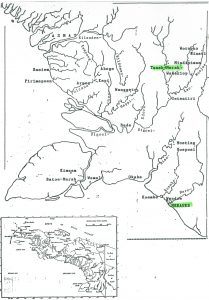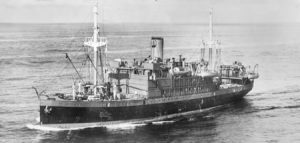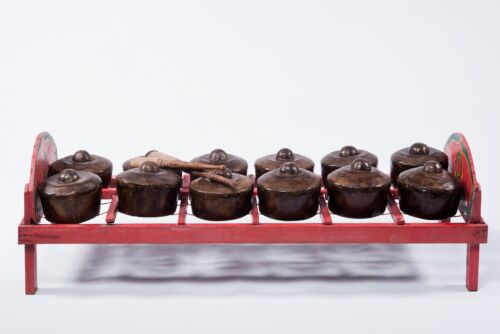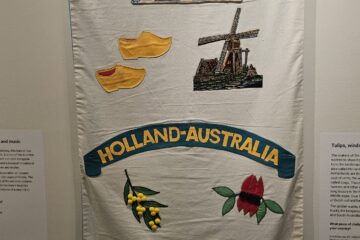We must go back in time to the internment camp at Tanah Merah on the Digul River in Dutch New Guinea, a place often referred to as a concentration camp, though not officially designated as such. The camp was established in 1927 in the aftermath of the Indonesian Communist uprisings of 1926–27. It was hastily constructed to isolate those considered the most dangerous elements of the Indonesian Communist Party (PKI).
By the start of WWII, a significant number of these political prisoners from the Netherlands East Indies (NEI) were still detained there. The camp, located deep in the malaria-infested jungle, was surrounded by dense rainforest, crocodile-infested rivers, and hostile conditions, which made escape nearly impossible. Its remote location meant that minimal resources were spent on security, while the internees were largely left to their fate under harsh conditions that had severe physical and psychological consequences.
For more detailed information on the camp, click here.

When the Japanese landed in Hollandia on May 6, 1942, the Dutch, in their hasty retreat, failed to destroy their facilities. As a result, the Japanese captured them intact, only to scorch the area and abandon it after taking what they needed. Meanwhile, the southern part of Dutch New Guinea, including the town of Merauke, remained outside Japanese control, becoming an important military base for the Dutch, Australians, and later the Americans. However, in 1942–43, this region was still precarious, with concerns about a potential Japanese advance.
Fearing that the political prisoners at Tanah Merah might ally with the Japanese in exchange for promises of greater independence, the Dutch decided to act. In 1943, they evacuated the internees to Australia. This marked a significant moment that brought the political realities of the Dutch colony into Australian focus and scrutiny.

In 1943 the Dutch decided to transport these prisoners to Australia. This was the start of an important episode that brought the political situation of the Dutch colony under the attention and scrutiny of the Australians.
Earlier, a few of the prisoners had escaped and fled to Australia across the Arafura sea that separates the two countries. Australia was therefore aware of the existence of this camp. The escapees had been sent back to the camp. Australia supported the Dutch rule of NEI and was never interested any further in the affairs of the northern neighbour.
One of history’s most amazing escapes
| There is a harrowing story of 4 prisoners escaping from Tanah Merah. Three of them survived the trip through 200kms of jungle – one was speared by a Papuan warrior on the way and later died. The other three arrived in Merauke and were cared for by the Melanesian population there and they received a canoe and ended up on Thursday Island. The escapees were able to hide themselves among the locals and even opened a shop (hairdressing)[2]. However, they were eventually picked up by the Queensland authorities and handed over to the Dutch. Trade unionists in Darwin petitioned the Australian Government to provide political asylum to these political prisoners but under the ‘White Australia policy’ that was cruelly refused. They ended up in the even more infamous Tanah inggi[3] concentration camp, just outside Tanah Merah. One of them Abdul Rachman was one of the prisoners who arrived in Australia for a 2nd time, this time brought by the Dutch (see below). In Australia Abdul became a student at an English language class for ‘Indonesians’ conducted by English teacher Mrs Gwyn Williams from Darlinghurst, who wrote down the stories of the students. Her teaching greatly assisted her students to far more effectively communicate in Australia and to create effective propaganda materials. There were several escape attempts to either Australian Papua New Guinea and one more to Australia (Thursday Island) but none of them were successful. In most situations they were captured or killed by Papua’s. |
The Dutch considered it safer to bring the political prisoners to Australia and in this they were supported by the Americans. This support was used by the Dutch to lobby for the Australian Government to achieve permission to bring them to Australia. Again the White Australian policy stood in the way, but finally they were allowed to be brought to camps outside the main cities. To the Australians these prisoners were presented as dangerous guerrillas rather than political prisoners.
Vice Governor NEI Charles van der Plas was send to Merauke to organise the evacuation. He had to travel 200kms over the Digul river to Tanah Merah – deep into the mosquito invested jungle. The prisoners had no idea that there was a world war going on and that the Japanese had taken over most of NEI. In the evacuation of the camp, a few old and sick prisoners were left behind as the Dutch reasoned that they would be of no use to the Japanese.
Prisoners of Tanah Merah included Mohammad Hatta and Soetan Sjahrir (they later became the first vice president and premier of the Indonesian Republik).
Interestingly after the invasion of NEI by the Japanese, the Dutch Governor van Mook offered Sjahrir – seen as a moderate nationalist -passage to Australia. He indicated that he would only accept this if the rest of the Tanah Merah prisoners would be set free, that of course didn’t happen, at least not at this stage.
The evacuation was a difficult and tedious affair. In all 295 political prisoners plus another 212 women and children as well as 40 guards. They all had to travel over the Digul River to Merauke. From here they were flown to Horn Island by Dutch Catalina seaplanes. A group of 22 internees – most likely the most senior ones where immediately transported on the Katoomba to Sydney. Non-internees (women and children) were brought by ship to MacKay, where they were accommodated.

The rest of internees came to Australia cramped in the Dutch KPM steamer ‘Both’. After departure from Merauke the ship docked for fresh supplies in the Queensland port of Bowen. From there it travelled to Sydney and after disembarking the prisoners went to Central Station and were transported by train to Liverpool on the outskirts of Sydney. Others were transported further to the prisoners-of-war camp in Cowra. Here they became known as the “Digulists” (back in Tanah Merah all people, prisoners and non-prisoners referred to themselves this way).
On their arrival in Australia some of the prisoners had secretly been able to pass on notes to one of the workers on the wharf in Bowen, indicating who they were and where they came from. This person happened to be a trade unionist. Through this network it ended up in the hands of Mr. J.C. Henry, the Queensland State leader of the Communist Party of Australia based in Brisbane. He personally took the note to Sydney. Many of the political prisoners were also communists, so there was an immediate kinship.
A second handwritten note from one of the original Indonesian railway strikers from 1926 – known to the Australians as Jo-Jo – reached the Civil Rights League in Sydney. This note mentioned the many sick (malaria) and asked for medical attention. (Jo-jo suffered from tuberculosis and died soon after his arrival in Sydney). The information reached some of the Australian soldiers who together with Dutch soldiers were involved in guarding the camps where these political prisoners were held. Once the Australians had established that these people were no friends of the Japanese, food and fruit parcels as well as medicines were rapidly organised for them. Laura Gapp of the Civil Rights League alerted the Australian Government about this situation. While there was not an instant result a process was started that a few months later would lead to the release of the prisoners.
The Dutch had been less than honest when they informed the Australian authorities that these prisoners were enemies of the allied forces and therefore had to be treated as prisoners of war. When that turned out not to be true, the Dutch were forced by the Australian Government to transport the sick to the Dutch Princess Juliana Hospital in Turramurra.
It was clearly seen as inappropriate for Australia to jail political prisoners from another country. Soon after the release of the sick, the rest of the prisoners who were kept in Liverpool were also set free. Finally, on December 7th, 1943 the detainees in Cowra were also released. Many of the freed prisoners joined trade unions. The result of this was that more Australians – especially trade-unionists – got a better understanding of the plight of the ‘Indonesians’. )
Once freed most of them went to a for them more climate friendly North Queensland. Some worked on the sugar plantations and others worked for the Dutch military forces in Mackay. It was here that they formed one of the first Indonesian Independence Committees in Australia, known as the Mackay Committee.
They would become the driving force behind the request for a boycott of Dutch ships. (See Black Armada)
With the Dutch NEI Government-in-exile now concentrated in Camp Columbia Brisbane (Wacol), the central office for the Indonesian independence movement was also established in Brisbane to coordinate the various independence activities in Australia.
An interesting anecdote, tells something about the social impact of the Digulists. It was advertised in the local Daily Mercury of 24 June 1944 that there was an upcoming soccer match between Mackay and the Javanese (Source Clogball).
Digulists instrumental in preparing for independence
The resistance to Dutch colonialism in Australia was now led by the Digulists.
Under the agreement with the Australian Government all evacuees from NEI were under the responsibility of the Dutch. These people had to be employed by them. When they refused to work for the Dutch they were imprisoned in one of the Dutch camps. In one way or another they had to be looked after by the Dutch. The White Australia policy made it impossible for them to seek work elsewhere. Over time the camps started to overflow with ‘Indonesian’ refusing to work for the Dutch.
Most of the Digulists were well educated and after they received their freedom they were eagerly sought after for jobs in the NEI administration in Australia. The main goal of the NEI Government in exile at this stage was to get rid of the Japanese, and the Digulists didn’t have any problems with that.
The Dutch remained rather naïve about the desire of the people to be independent and on one occasion a senior Dutch official mentioned that they would retain their colony for at least another 300 years[5].
The Digulists had, in these administrative positions, access to tools that allowed them to secretly establish and maintain contact with the nationalists in NEI. It looked like the Dutch didn’t seriously enough consider that these people would secretly use these positions to support the independence movement. In the end these ex-prisoners had sometimes better intelligence about the freedom movement in NEI than the Dutch they worked for.
At no time did these people resort to violence instead they used their employment positions to further their cause.
Among the ex-prisoners was also the hard core of the Communist Party of Indonesia (PKI) and they would play a key role in the Black Armada boycott against Dutch ships which started soon after the war, when the Netherlands launched their re-colonisation policy. However, based on lessons learned from previously failed activities – such as the 1926/27 uprising – and with the assistance of the Communist Party of Australia a more effective strategy was developed for the post-war era, headed by Djoko Sardjono (Soerdjono). He had been imprisoned in Tanah Merah since 1926, when he was arrested as the chairman of the Partai Komunis Indonesia (PKI), on his return from Australia to Indonesia in 1946 he again became the leader of the Communist Party in Indonesia.
It is rather ironic that after all the effort to keep the Digulists out of the hands of the Japanese, so they could not use the occupation to continue their fight for independence, they became potentially an even more potent force for the independence thanks to the Dutch bringing them to Australia.
The Gamelan Digul was brought to Australia

| When the concentration camp in Tanah Merah was evacuated, the prisoners brought with them to Australia a gamelan that had been constructed by them with the assistance of the Javanese court musician and political activist Pontjopangrawit, who had entertained at the court of king Paku Buwana X as a child. It was here that he learned how to build gamelans and became a sought-after teacher. He was imprisoned here from 1926 until 1932 but was later arrested by the Indonesian government during the 1965 revolution and died in custody. De camp doctor L.J.H. Schoonheyt mentions the gamelan. In translation: “Tanah Merah didn’t lack a gamelan (a Javanese drum orchestra) and this was especially in later years excellent. At the start they had to improvise, and it was made from empty tins of sardines and ‘patjols’, (stolen) blades from shovels. Later the prisoners were, at special festivities, allowed to borrow the gamelan from the military and it soon became clear that there were several excellent musicians amongst them. The native gamelan music fits much better with these people than the imported jazz music. Hopefully modern music will never replace it”[6]. A gamelan is the traditional ensemble of musical instruments used mainly in Java and Bali, made predominantly of percussive instruments. The most common instruments used are metallophones played by mallets and a set of hand-played drums called kendhang which register the beat. In the case of the Gamelan Digul this one was made from prison materials including pans and utensils – it was taken by the “Digulists” to the Cowra POW camp and from here it was taken by some of the musicians to Melbourne, where it was used in performances during the war. On the repatriation of the Digulists, it was presented to the Museum of Victoria and ended up at Monash University; some pieces are now in the Australian Museum in Canberra[7]. |
Paul Budde 2022
See also:
Dutch Camp Casino WWII – Archive Jan de Wit
Indonesian War Graves at Cowra (Netherlands East indies)
The Indonesian exiles in Australia, 1942-47 Rupert Lockwood
[1] Tanah Merah Concentration Camp http://paulbuddehistory.com/annie-budde-in-nieuw-guinea-in-dutch/tanah-merah-concentration-camp/
[2] Boven-Digoel – L.J.H. Schoonheyt https://www.papuaerfgoed.org/files/schoonheyt_1936_digoel.pdf

[3] Tanah Merah Concentration Camp http://paulbuddehistory.com/annie-budde-in-nieuw-guinea-in-dutch/tanah-merah-concentration-camp/
[4] Rupert Lockwood – Black Armada https://trove.nla.gov.au/work/26436607
[5] Wim van den Doel, Afscheid van Indië.
[6] Boven-Digoel – L.J.H. Schoonheyt https://www.papuaerfgoed.org/files/schoonheyt_1936_digoel.pdf
[7] The Gamelan Digul and the Prison Camp Musician Who Built It – http://profiles.arts.monash.edu.au/margaret-kartomi/2002-book-the-gamelan-digul-english-translation/


